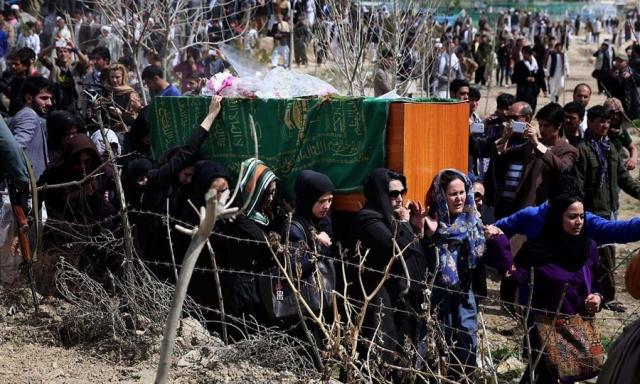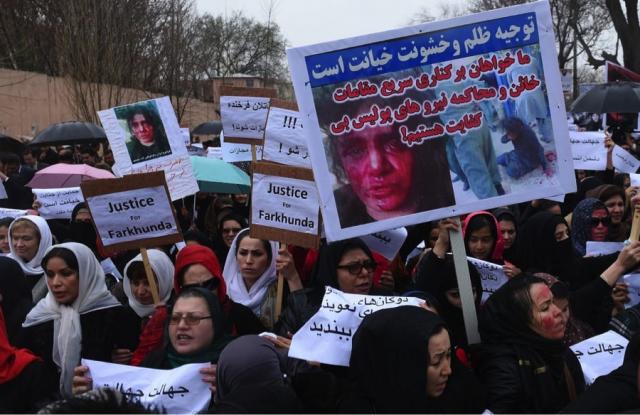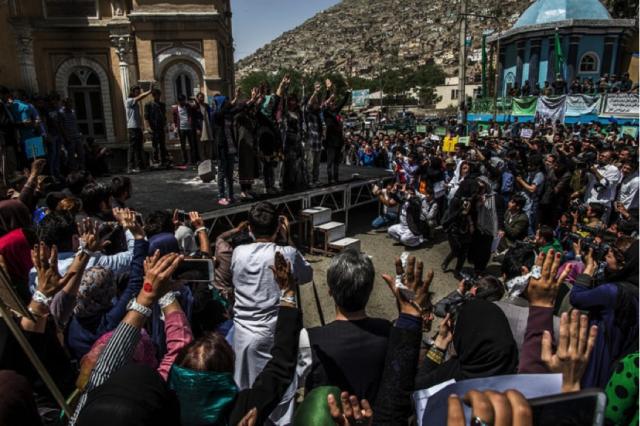Let Farkhunda's Death Not Be in Vain: the Movement Continues
In March 2015, a violent, hysterical mob beat, torched, and killed a woman, ran her over with a car, made her face unrecognizable, and threw her corpse in the Kabul river. Thousands of onlookers watched on like it was a spectacle to be enjoyed, not intervening, and hence, adding to the brutality.
The woman’s crime? “Burning the Quran”—which, as substantial evidence proved later, was an entirely false allegation.
To recap: Farkhunda Malikzada was a 27-year-old student of Islamic studies, a keen Muslim, and on her way to becoming a teacher. On March 19th, 2015, she challenged an amulet peddler for deceiving women desperate to have children, convincing them his wares would help. He retaliated by accusing her of burning the Quran. What followed shook Afghanistan, and garnered an international response from around the world.
Only 12 of the 49 men charged were convicted. 19 policemen were taken in as well, for providing insufficient protection to Farkhunda; ultimately, 8 of these were not penalized. The amulet seller, who was responsible for inciting the mob, did not receive a death penalty. It was clear, resounding indication that women are not safe in Afghanistan, and many had had enough.

No man was allowed to touch her coffin (source)
The Afghan public was enraged, and in a highly unprecedented move, it was women instead of men who carried her coffin to the grave, refusing to let even a single man touch it. A month later, a rally was held to protest her murder and demand justice. Some women donned blood-red masks made from an image of Farkhanda’s bloodied face during her attack. The Afghanistan Solidarity Party planted a tree where her body was buried. A group of rights activists staged an enactment of the murder, watched on by a tearful, deeply grieving crowd.
Even after all this, on 7th March 2016, the court reduced the sentences of the convicted men, and quashed four death sentences. Immense protests followed, and on 10th March, Afghan President Ashraf Ghani ordered his government to reopen the case, insisting that justice for Farkhunda be made top priority.

Afghan women protested outside the Supreme Court in Kabul on Tuesday, demanding justice for a woman named Farkhunda who was beaten to death last week after being falsely accused of blasphemy. CreditShah Marai/Agence France-Presse — Getty Images (source)
There is a hope there that the government will indeed listen to the voices of so many activists and civil society members who have been tirelessly protesting all year. It will be a sign that the situation of women can improve, that the legal system can provide.

The audience at the re-enactment on Monday of the killing of a woman named Farkhunda joined the cast in paying tribute to her. CreditBryan Denton for The New York Times (source)
WLUML networker Noorjahan Akbar is an Afghan activist who has been one the many Afghan women fighting tirelessly for justice. A year after Farkhanda’s death, she wrote about the issue, highlighting the situation for women and urging all to continue with their advocacy effort.
We interviewed her for a little more information, in the hope of contributing to the case and continuing the momentum of international outrage.
What is the current situation, both legally and socially, on the case?
NA: Since the Supreme Court decided to reduce sentences for nearly everyone arrested and prosecuted, President Ashraf Ghani promised to start a commission to investigate the case and how it was handled in March. There have been no new developments.
You said, "how can we expect Afghan women to protest, work, and exist in public spaces if we cannot ensure their basic safety or guarantee justice when their rights are violated?" What are some of the ways women's organisations in Afghanistan have considered tackling the issue, considering their safety is at stake in doing so?
NA: Despite the tremendous threats we face, Afghan women are incredibly resilient and constantly fighting against violence. In fact both immediately following Farkhunda’s murder and after the Supreme Court’s decision, activists, organizations and “ordinary” women organized in hundreds to protest the injustice. Organizations have also worked tirelessly to lobby for change at the governmental level.
A major and somewhat new development in women’s activism is their usage of social media. Women and their allies mobilized Facebook and Twitter not only to ask for justice but also drive Afghan and global media’s attention to Farkhunda’s story and her brutal murder and we continue to do this. Farkhunda’s murder and the protests that followed created a momentum. The challenge is to sustain that momentum and work for changing mentalities and ending all kinds of gender-based violence, not just the most public and brutal, and that requires increased literacy among Afghan women and increased security for Afghan advocates.
Would you say this kind of violent thinking comes from a particular socioeconomic class of men?
NA: Not at all. In fact some of the people who participated in the killing of Farkhunda were educated middle-class youth who took to social media to brag about their crime and defend their actions. 87% of Afghan women report facing some kind of violence at home. Surely all the culprits are not from a specific socio-economic background.
Are Afghan laws themselves discriminatory against women, or has this happened because of lack of proper legal implementation?
NA: Some of our laws need reform. Our laws regarding custody, divorce, and child marriage (16 is the legal age for girls’ marriage, 18 for boys) are some of those that need to change. But the problem goes beyond laws. We have laws that can be used to protect women. The Elimination of Violence Against Women act signed into law through a presidential decree in 2009 is technically the law of the land, but it is almost never implemented. The law is supposed to protect women against rape, forced marriage, harassment and a dozen other kinds of violence, but many judges refuse to use it for sentencing and prosecuting. In many parts of the country, the legal courts are not used at all for cases involving women. Instead families either refer to the Taliban or the local elders, which are always all-male groups and almost always have patriarchal views.
What is the reaction of the international community toward this issue, and how can activists across the world help in advocacy?
NA: Farkhunda’s brutal murder and the injustice that followed cause a lot of international attention. It reminded the world that Afghan women cannot be forgotten. It was telling of how fragile our accomplishments have been and how much harder we need to work for women’s rights and safety. Global petitions, articles, protests were empowering and energizing because we felt that we were not alone and that our sisters and allies around the world are enraged like us and willing to take a stand for justice.
What we need to do is to not wait for the next Farkhunda to continue this movement. We need to collaborate more and advocate continuously for women’s rights in Afghanistan and around the world and we have to make sure we tell our governments and the powerful men (as they often are) of our communities that we are watching them and we are holding them accountable. Farkhunda is dead. Let us make sure the movement to end gender-based violence remains alive and leads to actual cultural change around the world so that her death isn’t in vain.
A timeline on the events so far (source):
The Farkhunda murder
March 19, 2015: Farkhunda Malikzada, a 27-year-old legal scholar accused of burning a Quran, is lynched by a mob in Kabul.
March 22, 2015: Farkhunda is buried as news of her innocence comes to light. In an unprecedented move, women carry her coffin.
March 23, 2015: Hundreds take to the streets in Kabul to protest the murder. Twenty-three people are arrested in connection with the killing.
May 5, 2015: Four men are sentenced to death for murder, eight others to 16 years in prison. Other prime suspects are still at large.
July 2, 2015: An appeals court overturns the death sentences and hands down 10-20 year terms instead. Street protests break out.
March 7, 2016: Afghanistan’s Supreme Court confirms the decision to overturn the death sentences, nine convicted men have sentences reduced.
March 10, 2016: Afghan President Ashraf Ghani orders the case to be reopened, calls for justice for Farkhunda.
July 2016, 2016: No new developments to date.


